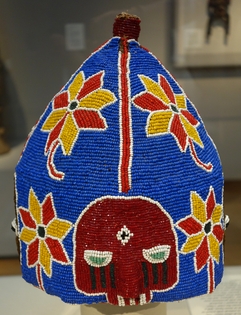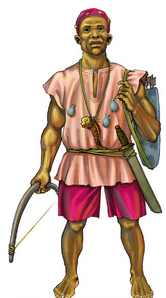
support@yorubalibrary.com
+2348073529208, 07038599574

Yoruba traditional jewelry and adornments are rich in cultural significance, symbolizing various aspects of identity, status, and spirituality. These items are not just decorative; they carry deep meanings and reflect the artistic heritage of the Yoruba people. In this article, we showcases different types of traditional jewelry and adornments, their materials, their cultural importance, and the occasions on which they are worn.
Types of Traditional Jewelry
Yoruba traditional jewelry includes a variety of pieces, each with its unique design and symbolism.
Beaded Jewelry
Ileke (Beads): Beads are a central element in Yoruba adornments, used in necklaces, bracelets, anklets, and waist beads.
Materials: Beads are typically made from glass, coral, bone, or metal.
Significance: Beaded jewelry signifies wealth, status, and spirituality. Certain beads are also believed to possess protective or healing properties.
Example: The "ileke idẹ" (brass beads) are often worn by royalty and high-status individuals.
Cowrie Shell Jewelry
Owó ẹyọ (Cowrie Shells): Cowrie shells are used in necklaces, headpieces, and other adornments.
Significance: Cowrie shells symbolize wealth and fertility. They are also used in divination practices.
Example: Cowrie shell necklaces and belts are commonly worn by priestesses and those involved in spiritual practices.
Metalwork Jewelry
Metal jewelry, including bracelets, rings, and earrings, is crafted from gold, silver, brass, and copper.
Significance: Metal jewelry is often associated with specific Orishas and can denote rank and authority.
Example: The "Ade" (crown) worn by kings and chiefs is adorned with gold and other precious metals.
Materials and Craftsmanship
The materials used in Yoruba jewelry are carefully selected for their beauty and symbolic meaning.
Gold and Silver
Significance: Gold and silver are precious metals that symbolize purity, wealth, and power. They are often used in ceremonial jewelry.
Craftsmanship: Skilled artisans create intricate designs using traditional techniques passed down through generations.
Coral and Amber
Significance: Coral and amber are valued for their vibrant colors and are often used in jewelry for special occasions.
Craftsmanship: Coral beads are meticulously hand-strung to create elaborate necklaces and bracelets.
Glass and Stone Beads
Significance: Glass and stone beads are versatile materials used in everyday adornments as well as in ceremonial pieces.
Craftsmanship: Beads are often hand-carved and polished to achieve a high-quality finish.
Cultural Significance
Yoruba traditional jewelry is deeply embedded in cultural and social practices.
Symbol of Status and Wealth
Practice: Jewelry indicates social status and wealth, with more elaborate and expensive pieces signifying higher status.
Example: Chiefs and royals wear large, ornate pieces that display their rank and authority.
Spiritual and Protective Qualities
Practice: Certain jewelry pieces are believed to offer protection, bring good luck, or connect the wearer to specific Orishas.
Example: Beads dedicated to Orisha Oshun are worn for love and fertility, while those for Orisha Ogun are worn for strength and protection.
Mark of Identity and Heritage
Practice: Jewelry can denote tribal identity, family heritage, and personal milestones.
Example: Waist beads are often given to girls during puberty rites and are worn throughout their lives as a symbol of femininity and fertility.
Occasions for Wearing Traditional Jewelry
Traditional Yoruba jewelry is worn during various significant events and ceremonies.
Festivals and Celebrations
Example: During festivals like the Osun-Osogbo Festival, participants adorn themselves with beads, cowrie shells, and metal jewelry to honor the Orishas and celebrate the occasion.
Rites of Passage
Example: Jewelry plays a crucial role in rites of passage such as weddings, where brides are adorned with elaborate beaded necklaces, bracelets, and headpieces.
Religious Ceremonies
Example: Priests and priestesses wear specific jewelry dedicated to their patron Orishas during religious rituals and ceremonies.
Conclusion
Yoruba traditional jewelry and adornments are a testament to the rich cultural heritage and artistic craftsmanship of the Yoruba people. These items carry profound meanings, symbolizing status, identity, spirituality, and protection. By understanding the types, materials, and cultural significance of these adornments, we gain a deeper appreciation for the traditions and values they represent. Embracing and preserving these practices helps to maintain the cultural identity and continuity of the Yoruba community.

Learn about the Yoruba concept of Ìwà Pẹ̀lẹ́ (good…

Learn special praises for Divine Being and Creator…